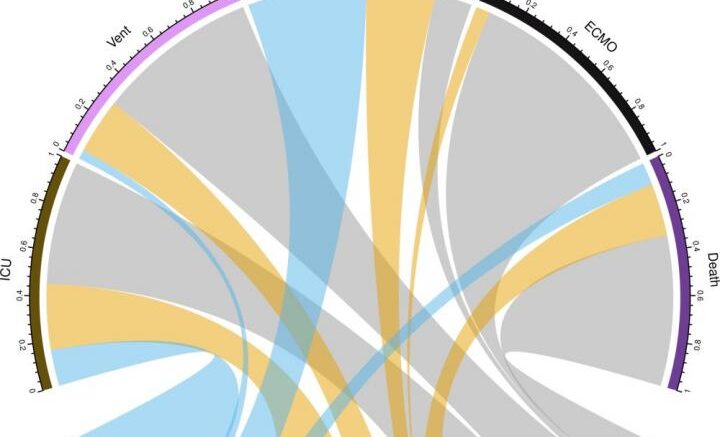Clinical outcomes by phenotype. Chord diagram illustrates the prevalence of clinical outcomes (% observed) for the three clinical phenotypes. Abbreviations: ICU (intensive care unit); Vent (mechanical ventilation); Readmit (readmission to hospital or ICU); ECMO (extracorporeal membrane oxygenation). Courtesy of Lusczek, et al.
In a new study, researchers identify three clinical COVID-19 phenotypes, reflecting patient populations with different comorbidities, complications and clinical outcomes. The three phenotypes are described in a paper published this week in the open-access journal PLOS ONE by authors Elizabeth Lusczek and Nicholas Ingraham of University of Minnesota Medical School and colleagues.
COVID-19 has infected more than 18 million people and led to more than 700,000 deaths around the world. Emergency department presentation varies widely, suggesting that distinct clinical phenotypes exist and, importantly, that these distinct phenotypic presentations may respond differently to treatment.
In the new study, researchers analyzed electronic health records (EHRs) from 14 hospitals in the midwestern United States and from 60 primary care clinics in the state of Minnesota. Data were available for 7,538 patients with PCR-confirmed COVID-19 between March 7 and August 25, 2020; 1,022 of these patients required hospital admission and were included in the study. Data on each patient included comorbidities, medications, lab values, clinic visits, hospital admission information, and patient demographics.
Most patients included in the study (613 patients, or 60 percent) presented with what the researchers dubbed "phenotype II." 236 patients (23.1 percent) presented with "phenotype I," or the "Adverse phenotype," which was associated with the worst clinical outcomes; these patients had the highest level of hematologic, renal and cardiac comorbidities (all p<0.001) and were more likely to be non-White and non-English speaking. 173 patients (16.9 percent) presented with "phenotype III," or the "Favorable phenotype," which was associated with the best clinical outcomes; surprisingly, despite having the lowest complication rate and mortality, patients in this group had the highest rate of respiratory comorbidities (p=0.002) as well as a 10 percent greater risk of hospital readmission compared to the other phenotypes. Overall, phenotypes I and II were associated with 7.30-fold (95% CI 3.11-17.17, p<0.001) and 2.57-fold (95% CI 1.10-6.00, p=0.03) increases in hazard of death relative to phenotype III.
The authors conclude that phenotype-specific medical care could improve COVID-19 outcomes, and suggest that future research is needed to determine the utility of these findings in clinical practice.
The authors add, "Patients do not suffer from COVID-19 in a uniform matter. By identifying similarly affected groups, we not only improve our understanding of the disease process, but this enables us to precisely target future interventions to the highest risk patients."
Reference: Lusczek ER, Ingraham NE, Karam BS, Proper J, Siegel L, Helgeson ES, et al. (2021) Characterizing COVID-19 clinical phenotypes and associated comorbidities and complication profiles. PLoS ONE 16(3): e0248956. https://doi.org/10.1371/journal.pone.0248956

Be the first to comment on "Study Suggests COVID-19 Patients Can Be Categorized Into Three Groups"